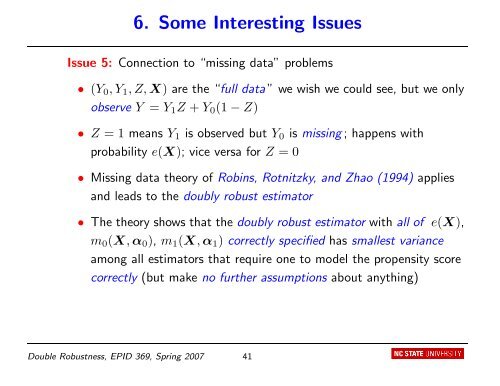Double Robustness in Estimation of Causal Treatment Effects
Double Robustness in Estimation of Causal Treatment Effects
Double Robustness in Estimation of Causal Treatment Effects
You also want an ePaper? Increase the reach of your titles
YUMPU automatically turns print PDFs into web optimized ePapers that Google loves.
6. Some Interest<strong>in</strong>g Issues<br />
Issue 5: Connection to “miss<strong>in</strong>g data” problems<br />
• (Y0, Y1, Z, X) are the “full data ” we wish we could see, but we only<br />
observe Y = Y1Z + Y0(1 − Z)<br />
• Z = 1 means Y1 is observed but Y0 is miss<strong>in</strong>g ; happens with<br />
probability e(X); vice versa for Z = 0<br />
• Miss<strong>in</strong>g data theory <strong>of</strong> Rob<strong>in</strong>s, Rotnitzky, and Zhao (1994) applies<br />
and leads to the doubly robust estimator<br />
• The theory shows that the doubly robust estimator with all <strong>of</strong> e(X),<br />
m0(X, α0), m1(X, α1) correctly specified has smallest variance<br />
among all estimators that require one to model the propensity score<br />
correctly (but make no further assumptions about anyth<strong>in</strong>g)<br />
<strong>Double</strong> <strong>Robustness</strong>, EPID 369, Spr<strong>in</strong>g 2007 41
















